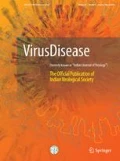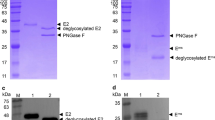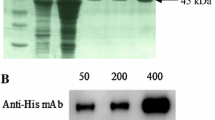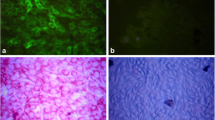Abstract
Classical swine fever (CSF) is an economically important Office International des Epizooties (OIE) list A disease of swine characterized by high fever and multiple haemmorhages. The E2 glycoprotein of CSFV is immunogenic and induces neutralizing antibodies against CSFV. In the present study, complete coding region of the E2 gene from Indian virulent field isolate (Mathura) was amplified by reverse transcription-polymerase chain reaction (RT-PCR) and subsequently cloned into a mammalian expression vector; pcDNA3.1(+) at BamHI and XbaI site. The recombinant plasmid; pcDNA.E2.CSFV. was confirmed by restriction enzyme digestion. The pcDNA.E2.CSFV. transfected Vero cell expressed E2 protein which was confirmed by western blotting, immunoperoxidase and indirect immunofluorescent tests. Additionally, flow cytometry analysis also confirmed that 15% of transfected Vero cells expressed the E2 glycoprotein compared to mock or vector alone transfected cells. Further study is under way to evaluate recombinant pcDNA.E2.CSFV. Mathura clone as DNA vaccine against CSFV.
Similar content being viewed by others
Introduction
Classical swine fever (CSF), also known as hog cholera, is a highly contagious viral disease of pigs that causes substantial economical loss to the pig industry worldwide [23]. The disease has been listed on list A of Office International des Epizooties (OIE). Infection with highly virulent CSFV strains can cause acute CSF characterized by high morbidity and mortality. Isolates of moderate to low virulence induce a prolonged, chronic disease [22].
The disease is caused by classical swine fever virus (CSFV) that belongs to the genus Pestivirus in the family Flaviviridae [10]. The other members of the genus Pestivirus include BVDV and BDV. The genome of the virus is a positive sense, single stranded RNA of approximately 12,300 nucleotides and flanked by 5′ and 3′ non-translating regions (NTRs) [4]. The proteins are arranged in the order Npro/C/Erns/E1/E2/P7/NS2-3/NS4A/NS4B/NS5A/NS5B. The Erns, E1 and E2 are major glycoproteins located in the outer membrane of the virion. These glycoproteins are involved in virus attachment and penetration into the host cells. Among them, the E2 glycoprotein is highly immunogenic and induces neutralizing antibodies [7, 24]. The E2 glycoprotein has been targeted for the development of immuno-diagnostics as well as immuno-prophylactics against CSFV [3, 11].
Currently in India, attenuated lapinised vaccine based on Weybridge strain of CSFV is being used for conferring protection against CSFV. Although it ensures protection against CSFV, it however requires cold chain similar to any other live attenuated vaccines [2]. DNA vaccines have several advantages including heat tolerance, safety, etc. [13]. In addition, they are also being used as marker vaccines to identify vaccinated infected and naturally infected animals [12].
Considering the advantages of DNA vaccines, in the present study, complete E2 gene of CSFV was cloned into a mammalian expression vector, pcDNA3.1(+) for use as DNA vaccine in future.
Materials and Methods
Tissue Samples
Tissue samples comprising spleen and lymphnode were collected from an outbreak of classical swine fever in Mathura, UP, India and was transported in 50% buffered glycerol and subsequently stored at −20°C until use.
Cell Line
Vero cell line obtained from the Molecular Biology Laboratory, Division of Animal Biotechnology was maintained in DMEM (Dulbecco’s Modified Eagles’ Medium) (Sigma, USA) supplemented with 10% foetal bovine serum (FBS) (Sigma), penicillin 100 units/ml and streptomycin 100 μg/ml.
Serum
The hyper-immune serum (HIS) raised against the lapinized swine fever vaccine virus in rabbits was used in the present study. The HIS was used for detection of expressed protein in western blot and flow cytometry, Immunoperoxidase Test (IPT) and Indirect Fluorescent Antibody Test (IFAT).
Bacterial Strains and Vectors
Escherichia coli (strain DH5α) was obtained from the repository of Molecular Biology Laboratory, Division of Animal Biotechnology, IVRI, Izatnagar. The PCR cloning vector ptz57R/T (MBI Fermentas, USA) was used for cloning the PCR product. Eukaryotic expression vector pcDNA3.1(+) (Invitrogen, USA) was used for expression studies.
Primers
Oligonucleotide primers used in the present study were procured from Genetix (India) and Hysel (India). Details of the primers used are given in Table 1.
Extraction of RNA
Tissue samples were pooled and a 20% tissue suspension was prepared in sterile PBS in pestle and mortar. Suspension was centrifuged at 3000×g for 10 min. Total RNA was extracted from 200 μl of supernatant using TRIreagent (Sigma, USA) as per the manufacturer’s protocol.
The RNA samples were properly labelled and stored at −20°C until use. Further, RNA extracted using TRIreagent was cleaned up using RNeasy Kit (QIAGEN, Germany) as per the protocol given by the manufacturer.
Reverse Transcription/cDNA Synthesis
For synthesizing the complementary DNA (cDNA) 5 μg of total RNA was mixed with 50 ng of random hexamer primer. The mixture in a PCR tube was heated to 70°C for 10 min and snap cooled on ice for at least 5 min. Thereafter, 4 μl of 5× RT buffer, 40 U RNase inhibitor, 500 μM dNTPs mix, 200 U RevertAid MMLV-RT were added. The contents were mixed properly. After a brief spun, the amplification was carried out in a thermal cycler (Biometra, UK) at 25°C 5 min followed by 1 h at 42°C. The enzyme was heat inactivated at 70°C for 15 min. The cDNA thus formed was stored at −20°C till further use.
PCR and nPCR for Amplification of Full Length E2 Gene
The cDNA was further used for amplification of full length E2 gene. The primers used were MBL/DBT/03 and MBL/DBT/04 (Table 1). The amplification was carried out in 50 μl reaction volume containing 1× Taq DNA polymerase buffer, 1.5 mM MgCl2, 20 pmol of each primer, 200 μM dNTPs, 5 μl cDNA 2 U of mixture of Taq DNA Polymerase + pfu Taq polymerase (16:1) (MBI Fermentas) and nuclease free water to make 50 μl. After initial denaturation at 95°C for 2 min, the amplification was carried out for 34 cycles each of 95°C–30 s, 52°C–45 s, 72°C–1 min with final extension of 10 min at 72°C. For nPCR, the procedure was essentially the same except that the template cDNA was replaced by 5 μl of primary PCR amplicons and MBL/DBT/05 and MBL/DBT/06 (Table 1). The annealing temperature was kept at 52°C. The authenticity of the amplicon was verified by its size in 1% Agarose gel and visualised on a UV trans-illuminator.
Cloning of E2 Gene into pcDNA3.1(+) Vector
RT-nPCR amplified complete E2 gene was purified from gel using QIAquick Gel Extraction Kit (QIAGEN, Germany) as per manufacturer’s instructions. E2 gene was cloned into PCR cloning vector, ptz57R/T provided in the InsT/Aclone™ PCR cloning kit (MBI Fermentas). The recombinant clone containing E2 gene (white colonies on IPTG, X-gal plate) was selected and grown in LB containing ampicillin. Recombinant plasmid was extracted and E2 gene insert was confirmed by BamHI and XbaI digestion showing band of approximately 1328 bp. The insert was gel purified and was sub-cloned into pcDNA3.1(+) mammalian expression vector at same BamHI and XbaI sites for expression studies. The recombinant pcDNA having E2 gene was confirmed by double restriction digestion using same BamHI and XbaI enzymes.
Sequencing of Recombinant Plasmid
The recombinant plasmid pcDNA.E2.CSFV.Mathura was got sequenced from the sequencing facility, University of Delhi, South Campus, New Delhi.
Transfection of Plasmid DNA into Eukaryotic Cells
Transfection grade pcDNA.E2.CSFV Mathura was prepared using ‘EndoFree Plasmid Maxi kit’ (QIAGEN) as per the manufacturer’s protocol. The pcDNA.E2.CSFV.Mathura was transfected into 70-80% confluent Vero cells in a six well plate using PolyFect® (QIAGEN, Germany) as per the manufacturer’s instructions. For SDS-PAGE, transfection was carried out in 25 cm2 cell culture flask. The cells were incubated at 37°C and 5% CO2 for 72 h.
In Vitro Expression Analysis
RT-PCR
At 72 h post transfection (p.t.), culture medium was removed from the wells and 1 ml TRIreagent was added on to cell monolayer and total RNA was extracted as described previously. The cDNA was synthesized and PCR was carried out using primers (VL/NBC/135 and VL/NBC/136) specific for the part of E2 gene as described Table 1.
SDS-PAGE and Western Blotting
SDS-PAGE analysis was carried out as per [17]. At 72 h p.t. both adherent and non-adherent cells (3 × 106) were pelleted and washed twice with ice-cold PBS. Cells were lysed by repeated freezing and thawing following treatment with lysis buffer [1% NP-40, 0.15 M NaCl, 5.0 mM EDTA, 10 mM Tris (pH 8.0)] containing protease cocktail inhibitors (Sigma). The lysate was left in ice-cold water for 10 min, and then centrifuged at 16,000 rpm for 5 min. Supernatant containing protein extract was mixed 1:1 with 2× gel loading buffer and boiled for 5 min. Samples were loaded along with pre-stained protein marker (New England Biolabs). Electrophoresis was carried out at a constant voltage at 130 V. Further, the expression was confirmed by western blotting using anti-rabbit horse-radish peroxidase (HRP) conjugated secondary antibodies (KOMA Biotech).
Flow Cytometry
At 72 h p.t., cells were harvested, washed once with PBS and fixed in 0.5% formaldehyde diluted in 0.5 ml PBS for overnight at 4°C. After washing twice with PBS for 5 min each, cells were incubated with anti CSFV rabbit hyper immune sera (1:20 dilution in 0.1 ml PBS) for 2 h at 37°C water bath. After washing twice with PBS, cells were incubated with anti-rabbit antibodies conjugated with FITC (1:50 in PBS) for 1 h at 37°C water bath. Following washing once with PBS, cells were resuspended in 0.5 ml PBS and acquired in FL1 filter of FACS Calibur. Cells transfected with empty vector pcDNA3.1(+) were used as vector control (vector transfected). On the other hand, cells without any treatment were used as control cells (mock-transfected). The percentage of cells showing the right shift in fluorescence intensity compared to that in vector or mock-transfected were quantified using Cell Quest software (Becton Dickinson).
Indirect Immunofluorescence Antibody Test (IFAT) and Immuoperoxidase Test (IPT)
At 72 h p.t. both mock-and pcDNA3.1.E2.CSFV-transfected cells were rinsed once with ice-cold PBS and fixed in 4% paraformaldehyde (PFA) for 20 min at RT. Further, the protocol was carried out as per to [14, 15].
Results and Discussion
Classical swine fever is a highly contagious and economically significant disease of domestic pigs and wild boars. The E2 gene engineered into an expression plasmid has been evaluated as DNA vaccine against CSF [5]. E2 is one of the three envelope glycoprotein of the CSFV that is involved in virus attachment, entry to target cells, virulence and immunogenicity [16].
RT-nPCR for the Amplification of Full-Length E2 Gene of CSFV
Total RNA extracted from tissue homogenate of clinical sample was reverse transcribed to get cDNA. Subsequently, the cDNA was amplified using primers specific for full-length E2 gene of the virus. The reasons for not getting the Primary PCR amplification could be due to poor condition of tissue materials and low titre of virus in tissues. Stadejek et al. [20] reported amplification in primary PCR after adapting the virus first in cell culture (PK-15 cell line) and passaging upto three times to increase its titre. However, a single band of specific size of 1328 bp was obtained for complete E2 gene in nested PCR (Fig. 1a). The absence of the band in non-template control validated the PCR. The use of random hexamer primers has been reported to increase the sensitivity of RT-PCR [8]. Thus in the current study random hexamer primers were used for reverse transcription. The Taq DNA polymerase lacks 3′ → 5′ exonuclease (proof reading) activity. The mis-incorporation of nucleotides might lead to premature termination of translation resulting in truncated protein [6]. To exclude such possibility, in our study, the E2 gene was amplified using the mixture of Pfu and Taq DNA polymerases. Each primer contained the recognition sites for the restriction enzymes BamHI (sense) and XbaI (anti-sense) and the amplified fragment of 1328 base pairs. The amplicon obtained harbored an ATG initiation codon in an optimized Kozak sequence context.
a Agarose gel electrophoresis showing amplification of full-length E2 gene of Mathura isolate. Lane 1: Negative template control. Lane 2: Amplification of 1328 bp PCR product for complete E2 gene. Lane M: Lambda DNA/EcoRI + HindIII Marker. b Agarose gel electrophoresis showing confirmation of E2 gene insert of Mathura isolate in pcDNA3.1(+) eukaryotic expression vector through restriction enzyme analysis. Lanes 1 and 3–6: Recombinant clones releasing 1328 bp insert on digestion with BamHI and XbaI restriction enzymes. Lane 2: Recombinant clone with no E2 gene insert. Lane M: Lambda DNA/EcoRI + HindIII Marker. Lane 7: Undigested Recombinant plasmid. c Agarose gel electrophoresis showing in vitro expression analysis at mRNA level by RT-PCR at 72 h post-transfection. Lane M: 100 bp DNA Ladder. Lane 1: No amplification in mock transfected cells. Lane 2: No amplification in vector transfected cells. Lane 3: Amplification of 271 bp PCR product in E2 transfected cells
The E2 Gene was Sub-Cloned into a Eukaryotic Expression Vector for Use as a DNA Vaccine
In the current study, the E2 gene from Mathura isolate was amplified and cloned into ptz57R/T, a T/A cloning vector. The release of approximately 1328 bp gene insert from the recombinant plasmid (ptz57R/T.E2.CSFV.Mathura) following digestion with BamHI and XbaI confirmed the successful cloning of E2 amplicons. The undigested ptz57R/T.E2.CSFV.Mathura was used as control.
The gel purified E2 gene insert (released from ptz57R/T vector) and pcDNA3.1(+) were ligated in 5: 1 ratio and subsequently transformed to E. coli DH5α cells. Full-length E2 gene was cloned into the polylinker (BamHI and XbaI sites) of pcDNA3.1+ vector to obtain plasmid pcDNA3.1/E2. The recombinant colonies were selected and propagated. The recombinant plasmids with E2 gene insert (pcDNA. E2.CSFV.Mathura) was confirmed following the release of 1328 bp gene insert after digestion with BamHI and XbaI (Fig. 1b). The vector has cytomegalovirus (CMV) promoter, bovine growth hormone polyadenylation signal and transcription sequence, f1 origin for single-stranded rescue of the sense strand DNA and SV40 origin for episomal replication. The studies by many workers revealed that vectors containing the CMV promoter and the bovine growth hormone termination signal, work well in the DNA vaccination [12, 21]. The recombinant plasmid pcDNA.E2.CSFV.Mathura was got sequenced and submitted to GenBank and available as Accession number EU567076.
The Ability of pcDNA.E2.CSFV.Mathura to Express the E2 Protein in Cultured Mammalian Cells was Confirmed
PolyFect® transfection reagent (QIAGEN, Germany) was used for transfection. It possesses a defined spherical architecture, with branches radiating from a central core and terminating at charged amino groups. PolyFect® assembles the DNA into compact structures, optimizing the entry of DNA into the cell.
RT-nPCR
The endotoxin free pcDNA3.1.E2.CSFV (1.5 μg) was mixed with PolyFect® and transfected to 60% confluent Vero cells. At 72 h p.t. both mock, vector and E2-transfected cells were harvested and examined for E2 expression by RT-nPCR. A 271 bp product was amplified from E2-transfected cells and not from that of vector or mock transfected cells, confirming the ability of pcDNA.E2.CSFV.Mathura to express E2 mRNA in eukaryotic cells (Fig. 1c).
Immunoblotting
The specificity of the E2 protein was also confirmed by immunoblotting analysis. A unique band of approximately 62 kDa was observed from the E2-transfected cell lysate. In-contrast, no such specific band was observed from the mock or vector-transfected cell lysate (Fig. 2). The above result established the expression of E2 protein in mammalian cells. Interestingly, band of approximately 62 kDa was detected instead of the expected 49–50 kDa protein. The E2 protein of CSFV has five N- and one O-linked glycosylation sites. The glycosylation not only determines its stability, virulence, antigenicity but also add to molecular weight of the E2 protein [19]. Similarly, in the current study, the detection of 62 kDa proteins up on incubation with hyper-immune serum raised against CSFV in rabbits could be attributed to the glycosylated nature of the expressed E2 protein.
Flow Cytometry
As shown in Fig. 3, 30.66% cells showed fluorescence intensity among E2-transfected as compared to 14.29% among mock and 16.34% among vector-transfected cells. The increase in percentage of cells showing the fluorescence intensity among E2 transfected compared to that from mock or vector-transfected cells suggested that nearly 15% of E2-transfected cells expressed the E2 protein.
Immunoperoxidase Technique
At 72 h post transfection mock, vector and pcDNA.E2.CSFV.Mathura-transfected cells were reacted with anti CSFV rabbit hyperimmune serum (1:20) raised against CSFV in rabbit. Following incubation with anti-rabbit antibodies (1:100), the reaction was visualized using AEC detection system (Sigma, USA). The appearance of pink colour in the cytoplasm of E2-transfected and not in mock or vector-transfected cells confirmed the expression of E2 protein (Fig. 4a).
Indirect Immunofluorescent Antibody Technique
Following incubation with anti CSFV rabbit hyperimmune serum (1:20) and subsequently by FITC-conjugated anti-rabbit antibodies (1: 500), the reaction was examined using a fluorescent microscope. The E2-transfected cells demonstrated the apple green fluorescence of higher intensity in the cytoplasm. In contrast, both vector and mock-transfected cells demonstrated a very faint fluorescence (Fig. 4b).
The DNA vaccines induce antigen specific immune responses [26]. Direct injection of DNA into skeletal muscle results in synthesis of proteins that can trigger the host immune system [9]. In animal models, DNA vaccines have been shown to elicit a broad range of immune responses similar to live vaccines [25]. Therefore, the E2 glycoprotein of CSFV is also being targeted for the specific diagnosis or immunoprophylaxis of CSF [1, 5]. Although the work on DNA vaccines against various strains of CSFV has been well focused in many other countries, however, so far no such reports have been documented against Indian strains from India.
The results of the present study would be useful for the development of DNA vaccine against CSF disease. Studies are required to test pcDNA.E2.CSFV.Mathura construct developed in inducing protective immune response in domesticated pigs.
References
Beer M, Reimann I, Hoffmann B, Depner K. Novel marker vaccines against classical swine fever. Vaccine. 2007;25:5665–70.
Bouma A, De Smith AJ, De Kluijver EP, Terpstra C, Moormann RJM. Efficacy and stability of a subunit vaccine based on glycoprotein E2 of classical swine fever virus. Vet Microbiol. 1999;66:101–14.
Colijin E, Blolmraad M, Wenswoort G. An improved ELISA for the detection of serum antibodies directed against classical swine fever. Vet Microbiol. 1997;59:15–25.
Elberts K, Tautz N, Becher P, Stoll D, Rumendpf J, Theil HJ. Processing in the Pestivirus E2-NS2 region; identification of proteins P7 & E2 P7. J Virol. 1996;70:4131–5.
Ganges L, Barrera M, Nunez JI, Blanco I, Frias MT, Rodriguez F, Sopbrinio F. A DNA vaccine expressing the E2 protein of classical swine fever virus elicits T cell responses that can prime for rapid antibody production and confer total protection upon viral challenge. Vaccine. 2005;23:3741–52.
Lundberg KS, et al. High-fidelity amplification using a thermostable DNA polymerase isolated from Pyrococcus furiosus. Gene. 1991;108:1–6.
Mauser R, Stettler P, Ruggli N, Hapmann MA, Tratsch JD. Oronasal vaccination with CSF replicon particles with either partial or complete deletion of the E2 gene induces partial protection against lethal challenge with highly virulent CSFV. Vaccine. 2005;23:3318–28.
McColl KA, Gould AR. Detection and differentiation of bluetongue virus using polymerase chain reaction. Virus Res. 1994;21:19–24.
Michel ML, Davis HL, Schleef M, Mancini M, Tiollais P, Whalen RG. DNA-mediated immunization to the hepatitis B surface antigen in mice: aspects of the humoral response mimic hepatitis B viral infection in humans. Proc Natl Acad Sci USA. 1995;92:5307–11.
Moennig V. Introduction to Classical Swine Fever: virus, disease and control policy. Vet Microbiol. 2000;73:93–102.
Muller A, Depner RK, Liess B. Evaluation of gp55 (E2) recombinant based ELISA for detection of antibodies induced by classical swine fever virus. Deutsche Tierdrztliche Wochenschrift. 1996;103:449–88.
Oshop GL, Elankumaran S, Vakharia VN, Heckert RA. In ovo delivery of DNA to the avian embryo. Vaccine. 2003;21(11–12):1275–81.
Patel C, Kataria RS, Tiwari AK, Gupta PK, Kumar S, Rai A. Cloning and expression of fusion gene of Newcastle disease virus in a eukaryotic expression system. Indian J Virol. 2007;18(1):8–12.
Ravindra PV, Tiwari AK, Ratta B, Chaturvedi C, Palia SK, Subudhi PK, Kumar R, Sharma B, Rai A, Chauhan RS. Induction of apoptosis in Vero cells by Newcastle disease virus requires viral replication, de-novo protein synthesis and caspase activation. Virus Res. 2008;133:285–90.
Ravindra PV, Tiwari AK, Ratta B, Chaturvedi C, Palia SK, Chauhan RS. Newcastle disease virus- induced cytopathic effect in infected cells is caused by apoptosis. Virus Res. 2009;141(1):13–20.
Risatti GR, Holinka LG, Sainz IF, Carrillo C, Lu Z, Borca MV. N-linked glycosylation status of classical swine fever virus strain brescia E2 glycoprotein influences virulence in swine. J Virol. 2007;81(2):924–33.
Sambrook J, Russel DW, Irwin N, Janssen KA. Molecular cloning a laboratory manual. 3rd ed. Cold Spring Harbor, New York: Cold Spring Harbor Laboratory Press; 2001. p. A8.43.
Sharma A. Molecular epidmiology of classical swine fever by sequence analysis of parts of virus genome. MVSc thesis. Submitted in Animal Biotechnology I.V.R.I.; 2003
Shi X, Elliott RM. Analysis of N-linked glycosylation of Hantaan virus glycoproteins and the role of oligosaccharide side chains in protein folding and intracellular trafficking. J Virol. 2004;78:5414–22.
Stadejek T, Vilcek S, Lowings JP, Pordany AB, Paton DJ, Belak S. Genetic heterogeneity of classical swine fever virus in Central Europe. Virus Res. 1997;52:195–204.
Suarez DL, Schultz-Cherry S. The effect of eukaryotic expression vectors and adjuvants on DNA vaccines in chickens using an avian influenza model. Avian Dis. 2000;44:861–8.
Van Oirschot JT. Hog cholera. In: Leman BSAD, Glock RD, Mengeling WL, Penny RHC, Scholl E, editors. Diseases of swine. 6th ed. Ames, Iowa: Iowa State University Press; 1986.
Van Oirschot JT, Trepstra C. In: Pensaert MO, editor. Virus Infections of porcines. Amsterdam: Elsevier; 1987. p. 113–30.
Van Rijn PA, Bessers A, Wenswoort G, Moormann RJM. Classical swine fever virus (CSFV) envelope glycoprotein E2 containing one structural antigen unit protects pigs from lethal CSFV challenge. J Gen Virol. 1996;77:2737–45.
Yasutomi Y, Robinson HL, Lu S, Mustafa F, Lekutis C, Arthos J, Mullins JI, Voss G, Manson K, Wyand M, Letvin NL. Simian immunodeficiency virus-specific cytotoxic T-lymphocyte induction through DNA vaccination of rhesus monkeys. J Virol. 1996;70:678–81.
Yokoyama M, Zhang J, Whitton JL. DNA immunization confers protection against lethal lymphocytic choriomeningitis virus infection. J Virol. 1995;69:2684–8.
Acknowledgements
Authors wish to thank the Director, Indian Veterinary Research Institute, Izatnagar 243 122 (UP) for providing necessary facilities to carry out the work and ICAR for providing financial Assistance under AP-Cess Scheme.
Author information
Authors and Affiliations
Corresponding author
Rights and permissions
About this article
Cite this article
Ratta, B., Nautiyal, B., Ravindra, P.V. et al. Characterization and Expression of E2 Glycoprotein of Classical Swine Fever Virus in a Eukaryotic Expression System. Indian J. Virol. 21, 69–75 (2010). https://doi.org/10.1007/s13337-010-0009-9
Received:
Accepted:
Published:
Issue Date:
DOI: https://doi.org/10.1007/s13337-010-0009-9








